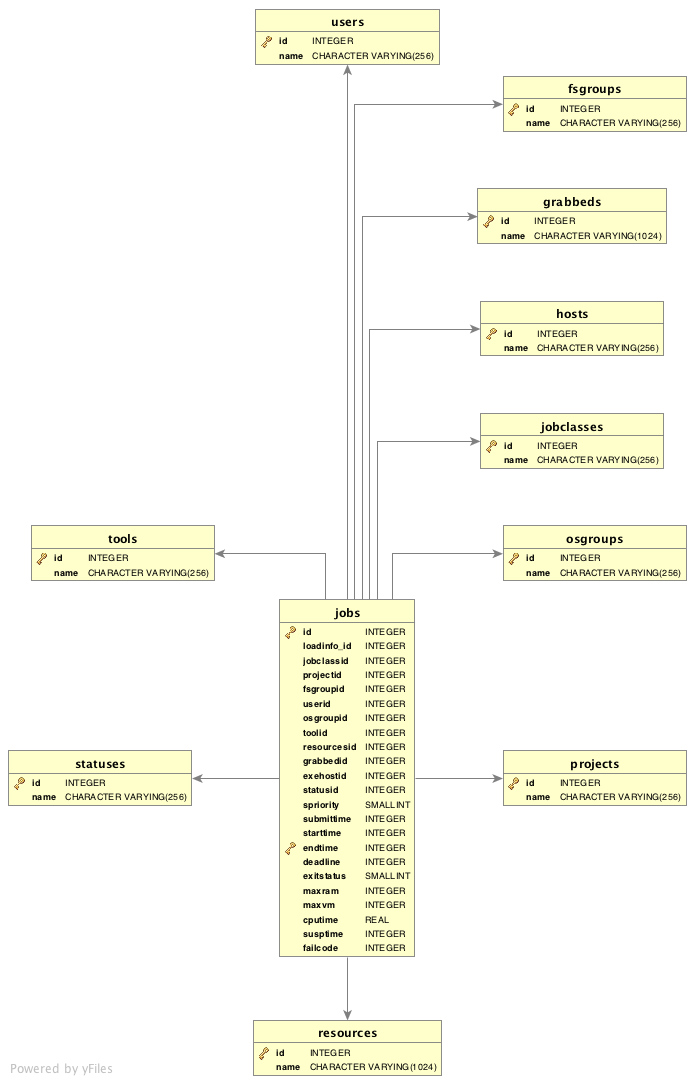Database Schema
The SQL schema used by this version of Accelerator is visualized in the following entity-relationship diagram.

Figure 1. The Accelerator Database Schema
View new features for Accelerator 2024.1.0.
Discover the available Altair Accelerator guides.
Discover Accelerator functionality with interactive tutorials.
Basic tasks in Accelerator, including submitting jobs, tracking job information, and analyzing and solving common problems.
Configure and manage the use of Accelerator after it is installed.
Accelerator documentation is available in HTML and PDF format.
Accelerator has two main commands, nc and ncmgr.
Accelerator stores historical information about jobs in a relational database. As of version 2015.09, the database is fully integrated and managed as part of Accelerator. This section provides an overview of the components that run and manage the database.
The command line utility vovdb_util can be used to configure most aspects of the Accelerator database. You must have ADMIN privileges on the Accelerator server to configure and control the database.
Accelerator includes version 14.4 of the PostgreSQL database engine that is used by the VOV database daemon vovdb. This section describes how to determine if a database upgrade will be needed when upgrading the Accelerator product software.
This section details the methods that Accelerator uses to load data into the database.
One function of the utility vovdb_util is to export the database into jobs data files. The exported files are saved in the vnc.swd/data/dump directory.
There are two ways to do direct backups of the database: automatic and manual. In addition, the original source data files may be saved.
The script jobplots.cgi can generate plots of jobs over a period of time. The jobs are organized by project, user, host, or jobclass.
The Accelerator database is open for custom queries using SQL.
The SQL schema used by this version of Accelerator is visualized in the following entity-relationship diagram.
Preemption is the process of reserving or revoking resources from other jobs in order to help "important jobs" finish quickly.
Altair Accelerator includes a subsystem for managing computing resources. This allows the design team to factor in various constraints regarding hardware and software resources, as well as site policy constraints.
This is a usage guide for the Resource Data Service (RDS), an alternative service for managing License resources and License-first scheduling in Accelerator.
The Streaming Data Service (SDS) publishes a time series data stream that can be consumed by existing Kafka systems and compatible reporting tools to monitor VOV projects.
To ensure the correct and repeatable behavior of the tools, the environment must be controlled. This chapter explains how VOV supports multiple reusable environments.
This section provides instructions to change the software version on which Accelerator runs.
This daemon vovfilerd replaces older daemons like vovisilond, vovnetappd and vovregulatord. Also the utility vovfiler_setup is no longer needed. The visualization of the filer information is now done either via the vovfilerd.cgi page or via the utility vovfilerdgui.
This chapter provides information about deprecated features that are still supported. This information is provided should you see older commands in use after a software upgrade or migrating to a newer Accelerator.
Configure and manage the use of Accelerator after it is installed.
Accelerator stores historical information about jobs in a relational database. As of version 2015.09, the database is fully integrated and managed as part of Accelerator. This section provides an overview of the components that run and manage the database.
The SQL schema used by this version of Accelerator is visualized in the following entity-relationship diagram.
The SQL schema used by this version of Accelerator is visualized in the following entity-relationship diagram.

Copyright (c) 1994-2023. Altair Engineering, Inc. All Rights Reserved. Contains trade secrets of Altair Engineering, Inc. Copyright notice does not imply publication.
Intellectual Property Rights Notice | Technical Support | Cookie Consent